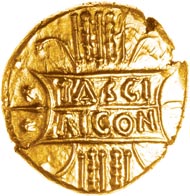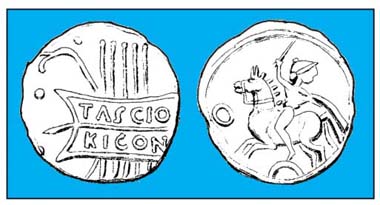by Chris Rudd
A gold stater of Tasciovanos – one of the finest known – was recently found near Verlamion (St. Albans, Herts.) ancient capital of the Catuvellauni (‘men excelling in battle’). It comes from the final series of gold staters issued by Tasciovanos (‘killer of badgers’) who commanded the Catuvellauni for about thirty years, from around 25 BC – not long after the Senate had made Octavian ‘Augustus’ – to about AD 10. There are three notable features of these gold staters:
Tribute money? Tasciovanos gold stater found near St. Albans, Herts. To be sold by Chris Rudd in January 2014. Photo: E. Cottam.
- They are among the most boastful coins ever minted by a British or Gaulish ruler. In large letters set in a monumental panel they proclaim that Tasciovanos is ‘rigon,’ a British title which means ‘king’ or perhaps even ‘high king’.
- They reveal a sudden and inexplicable increase in gold content – an increase of almost 15% over the previous gold staters of Tasciovanos and significantly more than the gold coins of other British rulers.
- They contain a number of spelling mistakes – even the king’s name gets blundered and has to be corrected – which suggests that these gold staters were made in a hurry without the customary quality control, which is all the more surprising because the royal inscription was clearly intended to create an impression of regal splendour.
Tasciovanos blazons his kingly status more blatantly than any other British or Gaulish monarch. Ricon (often ricon) means ‘king’, as in the Scottish place-name Rerigonium ‘very royal (place)’, near Loch Ryan, whose name it takes. Cartouche from stater of Sir John Evans found at St Ives, Cambs., 1858. Picture: F.W. Fairholt, 1864.
Whom was Tasciovanos trying to impress? Why was the old king showing off at the end of his long reign? His power and prestige must already have been well known in Britain. Was he polishing his legacy like modern presidents and prime ministers do before they leave high office? If so, why did he go to the totally unnecessary expense of putting extra gold into his final staters? And why were these important, self-publicising gold staters apparently churned out in such a rush? Dr John Sills, author of ‘Gaulish and early British gold coinage’ (Spink 2003) and co-author of ‘Ancient British Coins’ (Chris Rudd 2010), has raised the possibility that these RIGON staters may have been minted as tribute money to be paid to Augustus.
Tasciovanos gold stater, 48% gold, reportedly ‘procured by the Rev. E. Trafford Leigh from a peasant at Rome.’ How did it get there? Acquired by the British Museum in 1855. Picture: J.Y. Akerman, 1846.
Tasciovanos paying tribute to Augustus? That’s an intriguing idea. I know that in 54 BC Caesar demanded that the Britons, led by Cassivellaunos, should pay an annual tribute to Rome. Did Augustus invoke this treaty half a century later and, if so, why? I asked John Sills to tell me very briefly why he thought RIGON staters might have been tribute money. He said: ‘I’ve been puzzling about why their gold content is so much higher than anything else, why they’re often so carelessly struck compared to earlier types, with spelling mistakes etc, and why they’re nearly all die linked. It makes absolutely no sense for a powerful British ruler to suddenly increase the gold content of his coinage by 15% to almost 50% in total isolation. I was going to suggest the usual military campaign explanation but then saw Evans’ comment that a RIGON stater had been bought from a peasant in Rome [John Evans, ‘The Coins of the Ancient Britons’, 1864, page 270] and I thought they could be a tribute coinage. The start of the RIGON series coincides exactly with Dubnovellaunos being kicked out of Essex (and perhaps Kent) and fleeing to Augustus. The latter clearly didn’t reinstate him, but what if he invoked Caesar’s treaty with Cassivellaunos and demanded tribute as recompense, with the threat of invasion if Tasciovanos didn’t comply? There’s good evidence that in the Gallic Wars Caesar insisted on a minimum gold content of 50% for tribute payments and the 47% average of the RIGON staters looks like the minimum Tasciovanos could have got away with, without the shortfall being detected. This has huge implications for the reach of Augustus into British politics; as far as I know no-one has ever suggested it, but it rings true to me.’ Me too. John Sills’ article ‘The tribute staters of Tasciovanos?’ will be published in January 2014 in Chris Rudd List 133.
For more information on Chris Rudd and his auctions, please visit his website.
If you are interested in Celtic coins and history, don’t miss our archive!









